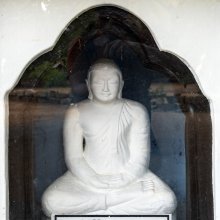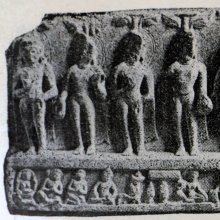Kanakamuni: 9 definitions
Introduction:
Kanakamuni means something in Buddhism, Pali, Hinduism, Sanskrit. If you want to know the exact meaning, history, etymology or English translation of this term then check out the descriptions on this page. Add your comment or reference to a book if you want to contribute to this summary article.
Images (photo gallery)
In Buddhism
Theravada (major branch of Buddhism)
Source: Pali Kanon: Pali Proper NamesSee Konagamana.
Theravāda is a major branch of Buddhism having the the Pali canon (tipitaka) as their canonical literature, which includes the vinaya-pitaka (monastic rules), the sutta-pitaka (Buddhist sermons) and the abhidhamma-pitaka (philosophy and psychology).
Mahayana (major branch of Buddhism)
Source: Wisdom Library: Maha Prajnaparamita SastraKanakamuni (कनकमुनि) or “golden sage” is the name of a Buddha according to the according to the 2nd century Mahāprajñāpāramitāśāstra (chapter XV).—Accordingly, “... During the good kalpa, there were four Buddhas, Krakucchanda, Kanakamuni “golden sage”, Kaśyapa and Śākyamuni”.
According to the Mahāvadānasūtra, Buddha Kanakamuni had an “assistant” (upasthāyaka) named Svastika.—Each Buddha had his assistant (upasthāyaka), a monk specially attached to his person, entrusted with fanning him, carrying his robe and bowl for alms-round, introducing visitors. The Sanskrit Mahāvadānasūtra has drawn up a list of the assistants who served the last seven Buddhas: [...] Svastika for Kanakamuni [...]

Mahayana (महायान, mahāyāna) is a major branch of Buddhism focusing on the path of a Bodhisattva (spiritual aspirants/ enlightened beings). Extant literature is vast and primarely composed in the Sanskrit language. There are many sūtras of which some of the earliest are the various Prajñāpāramitā sūtras.
Tibetan Buddhism (Vajrayana or tantric Buddhism)
Source: Wisdom Library: Tibetan BuddhismKanakamuni (कनकमुनि) is the name of a Tathāgata (Buddha) mentioned as attending the teachings in the 6th century Mañjuśrīmūlakalpa: one of the largest Kriyā Tantras devoted to Mañjuśrī (the Bodhisattva of wisdom) representing an encyclopedia of knowledge primarily concerned with ritualistic elements in Buddhism. The teachings in this text originate from Mañjuśrī and were taught to and by Buddha Śākyamuni in the presence of a large audience (including Kanakamuni).
Source: archive.org: The Indian Buddhist IconographyKanakamuni (कनकमुनि) refers to one of the seven mortal Buddhas (mānuṣī) whose names appear last in the list of thirty-two Buddhas in Mahāyāna Buddhism.—The last seven Tathāgatas are well-known, and are designated by the Mahāyānist as Mānuṣī or “Mortal Buddhas”. When represented, the last seven Mortal Buddhas appear all alike; they are of one colour and one form, usually sitting cross-legged,with the right hand disposed in the Bhūmisparśa-mudrā (earth-touching attitute), which is the mudrā peculiar to Akṣobhya. [...] In paintings, the Mortal Buddhas [viz., Kanakamuni] have usually a yellow or golden complexion. [...] Sometimes they are represented as standing, in which case the appear under a distinguishing Bodhi Tree and with a distinguishing mudrā.
Kanakamuni is associated with the (Mortal) Buddhaśakti named Kaṇṭhamālinī, and together they bring into existence the (Mortal) Bodhisattva named Kanakarāja.

Tibetan Buddhism includes schools such as Nyingma, Kadampa, Kagyu and Gelug. Their primary canon of literature is divided in two broad categories: The Kangyur, which consists of Buddha’s words, and the Tengyur, which includes commentaries from various sources. Esotericism and tantra techniques (vajrayāna) are collected indepently.
General definition (in Buddhism)
Source: Wisdom Library: Dharma-samgrahaKanakamuni (कनकमुनि) refers to the fifth of the “seven Buddhas” (saptatathāgata) as defined in the Dharma-saṃgraha (section 6). The Dharma-samgraha (Dharmasangraha) is an extensive glossary of Buddhist technical terms in Sanskrit (e.g., saptatathāgata and Kanakamuni). The work is attributed to Nagarguna who lived around the 2nd century A.D.
Languages of India and abroad
Sanskrit dictionary
Source: Cologne Digital Sanskrit Dictionaries: Edgerton Buddhist Hybrid Sanskrit DictionaryKanakamuni (कनकमुनि).—(Tibetan gser thub, gold muni), also Kanaka ((Ārya-)Mañjuśrīmūlakalpa 130.4, prose, Kanakādyais tathāgatair; Laṅkāvatāra-sūtra 365.5, with Krakucchanda and Kāśyapa), Kanakā- hvaya (the one named Kanaka, Lalitavistara 281.14; 283.17, with the same two others), in (Ārya-)Mañjuśrīmūlakalpa 68.27 text corruptly Kabaka- grani; in Mahāvastu Kanakamuni i.294.20; 318.13 (in the former with the prefix Bhāna- or Bhāma-, q.v., according to text), but otherwise in Mahāvastu only Konākamuni (or Koṇ°; Senart usually gives n, but see his Introd. to i p. xiv f.; also Konāka-nāmo, nom. sg., ii.300.4; 336.8, and Konāka- sāhvayo ii.401.7); this form occasionally in other texts, (Ārya-)Mañjuśrīmūlakalpa 426.9 in a confused list also containing the other form (Kanakamuni, Kāśyapa, Krakutsanda, Śikhin, Viśva- bhu, Konākamuni!), also Laṅkāvatāra-sūtra 29.1 = 142.14; Mahā-Māyūrī 227.17 (but Kanakamuni Laṅkāvatāra-sūtra 141.9; Mahā-Māyūrī 250.10, and Kanaka Laṅkāvatāra-sūtra 365.5); Konāgamuni Karmavibhaṅga (and Karmavibhaṅgopadeśa) 97.1, 5 (but Kanaka- muni 71.21; and so v.l. 97.1, 5; same verse in Pali Therīg. 518, Koṇāgamana) = Pali Koṇāgamana or Konā° (even in late Pali, Buddhavaṃsa commentary 213.14, according to Malalasekara (Dictionary of Pali Proper Names), the form Kaṇakāgamana is used in a popular etymology of the name; doubtless Koṇāka or Koṇāga- was original), Aśokan Konākamana, name of a former Buddha, next but one before Śākyamuni, preceding Kāśyapa and following Krakucchanda, qq.v.; often mentioned with these two, see list of passages s.v. Krakucchanda; mentioned alone, besides some passages cited above, Avadāna-śataka ii.34.11.
--- OR ---
Kanakamuni (कनकमुनि) or Kanakāhvaya.—q.v.
--- OR ---
Kanakamuni (कनकमुनि) or Koṇākamuni.—q.v.
--- OR ---
Kanakamuni (कनकमुनि) or Konāka or Konākanāma or Konākamuni or Konāka-sāhvaya or Konāgamuni.—q.v.
Source: Cologne Digital Sanskrit Dictionaries: Monier-Williams Sanskrit-English DictionaryKanakamuni (कनकमुनि):—[=kanaka-muni] [from kanaka > kan] m. Name of a Buddha, [Lalita-vistara]
[Sanskrit to German]
Sanskrit, also spelled संस्कृतम् (saṃskṛtam), is an ancient language of India commonly seen as the grandmother of the Indo-European language family (even English!). Closely allied with Prakrit and Pali, Sanskrit is more exhaustive in both grammar and terms and has the most extensive collection of literature in the world, greatly surpassing its sister-languages Greek and Latin.
See also (Relevant definitions)
Partial matches: Muni, Kanaka.
Ends with: Bhamakanakamuni.
Full-text (+16): Bhana, Kanakahvaya, Konakamuni, Konagamana, Konaka, Konakasahvaya, Konakanama, Konagamuni, Vipashyin, Krakucchanda, Kanakaraja, Kashyapa, Shobha, Svastika, Kanthamalini, Seven Buddhas, Saptatathagata, Ayuhpramana, Kanaka, Sarvamitra.
Relevant text
Search found 14 books and stories containing Kanakamuni, Kanaka-muni; (plurals include: Kanakamunis, munis). You can also click to the full overview containing English textual excerpts. Below are direct links for the most relevant articles:
Maha Prajnaparamita Sastra (by Gelongma Karma Migme Chödrön)
I. Apparent longevity of the buddhas < [Part 16 - Obtaining the immense longevity and immense radiance of the Buddhas]
The Sumedhā-Jātaka < [I. Puṇyakriyāvastu consisting of generosity]
Appendix 7 - The Buddha’s assistants (upasthāyaka) < [Chapter XLI - The Eighteen Special Attributes of the Buddha]
The Indian Buddhist Iconography (by Benoytosh Bhattachacharyya)
The travels of Fa-Hian (400 A.D.) (by Samuel Beal)
A Record of Buddhistic Kingdoms (by Fa-Hien)
The gods of northern Buddhism (by Alice Getty)
The Mahavastu (great story) (by J. J. Jones)
Chapter XXIX - The Buddha in Veśālī (Vaiśālī) < [Volume I]
Chapter XXXI - Ghatikāra and Jyotipāla < [Volume I]
Related products



